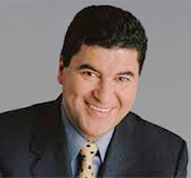Arab Americans
Dr. Elias Zerhouni
Elias A. Zerhouni (Arabic: إلياس زرهوني) (born April 12, 1951) is an Algerian-born American radiologist and medical researcher. He was the 15th director of the National Institutes of Health, appointed by George W. Bush in May 2002. He served for 6 years, stepping down in October, 2008.
Background
A resident of Pasadena, Maryland, Zerhouni is of Algerian descent. He was born in Nedroma in Tlemcen Province. He emigrated to the United States at age 24, having earned his M.D. at the University of Algiers School of Medicine in 1975. After completing his residency in diagnostic radiology at Johns Hopkins in 1978 as chief resident, he served as assistant professor in 1979 and associate professor in 1985. Between 1981 and 1985, he was in the department of radiology atEastern Virginia Medical School and its affiliated DePaul Hospital. In 1988, Zerhouni returned to Johns Hopkins where he was appointed director of the MRI division, becoming chair of the Russell H. Morgan department of radiology and radiological science, and Martin Donner professor of radiology and professor of biomedical engineering. Zerhouni went on to serve as Executive Vice-Dean of Johns Hopkins University School of Medicine.
Zerhouni (Johns Hopkins University’s) MRI division’s imaging research led to major advances in Computerized Axial Tomography (CAT scanning) and Magnetic Resonance Imaging (MRI). This MRI division is credited with developing novel quantitative imaging methods used for diagnosing cancer, cardiovascular and pulmonary disease. As one of the world’s premier experts in computed tomography and magnetic resonance imaging (MRI), this department extended the role of CT and MRI from taking snapshots of gross anatomy to visualizing how the body works at the physiologic and molecular level. This MRI division pioneered magnetic tagging, a non-invasive method of using MRI to track the motions and accurately measure the function of a heart in three dimensions. This MRI division is also known for refining an imaging technique called quantitative computed tomographic (CT) densitometry that helps discriminate between non-cancerous and cancerous nodules in the lung and for developing and applying the method of High Resolution CT for the study of heart and lung structure and function and for diagnosing cancer.
Partly based on this MRI division’s research and inventions (Johns Hopkins University’s), Zerhouni founded or co-founded 5 start up companies. He founded Computerized Imaging Reference Systems (CIRS) in 1982 where he served as founder and chairman for several years. CIRS is headquartered in Norfolk, Virginia. He founded Advanced Medical Imaging in 1989, which was later sold to a major public company. He is a co-inventor and co-founder of Biopsys Corporation which became public before being acquired by a major public company in 1996. He co-founded American Radiology Services and served as chairman and CEO of it until 2002 and he is a co-inventor and co-founder of Surgivision, Inc. an MRI image guided surgery company. This MRI division’s research in imaging led to advances in Computed tomography (CAT scanning) and Magnetic Resonance Imaging (MRI) that resulted in 157 peer reviewed publications and 8 patents.
In 1985, he was a consultant to the White House under President Ronald Reagan. In 1988, he was a consultant to the World Health Organization. Since 2000, he has been a member of the National Academy of Sciences‘ Institute of Medicine. He had served on the National Cancer Institute‘s Board of Scientific Advisors from 1998-2002.He has won several awards for his research including a Gold Medal from the American Roentgen Ray Society for CT research and two Paul Lauterbur Awards for MRI research. Zerhouni received the honorary title Doctor Emeritus from the University of Algiers in 2005. He received the Légion d’honneur from the French National Order in 2008. In 2010, Zerhouni received an honorary degree (L.H.D.) from Johns Hopkins University for service to the university and the nation.[1]
Since leaving the NIH, Zerhouni has been appointed to the boards of the Lasker Foundation, Research!America, and the Mayo Clinic. He joined the board of trustees for King Abdullah University of Science and Technology (KAUST) when the school opened in September,2009. He was also named by Maryland Governor Martin O’Malley to the chairmanship of the Maryland Economic Development Commission. Zerhouni was also recently appointed as Chief Scientific Advisor of Science-Translational Medicine, a sister publication of Science Magazine of the American Association for the Advancement of Science (AAAS). He also advises the CEO of a global pharmaceutical and vaccines company, Sanofi-Aventis, on science and technology issues and serves on the board of Actelion Pharmaceuticals, a Swiss biotechnology company. He is also a Professor of Radiology and Biomedical Engineering at Johns Hopkins University.[2]
Most recently, in 2010, Zerhouni formed the Zerhouni Group, LLC, a global science and health consulting firm. In addition, Dr. Zerhouni has been a scientific advisor to Chief Executive Chris Viehbacher of sanofi-aventis since February 2009. Lately, sanofi named Dr. Zerhouni as the new head of research and development on Tuesday, Dec 14 2010 and will report directly to the CEO. Of late, it has been mentioned, that he is a Senior Fellow at the Bill & Melinda Gates Foundation (Global Health), and is Chief Scientific Advisor to the prestigious journal Science Translational Medicine, of the AAAS.
National Institutes of Health
Soon after becoming the Director of the National Institutes of Health (NIH), in May 2002, Zerhouni convened a series of meetings to chart a “Roadmap for Medical Research” in the 21st century. The purpose was to identify major opportunities and gaps in biomedical research that no single Institute at NIH could tackle alone, but that the agency as a whole must address to make the biggest impact on the progress of medical research. Developed with input from meetings with more than 300 nationally recognized leaders in academia, industry, government, and the public, the NIH Roadmap provided a framework of priorities that the NIH as a whole must address in order to optimize its entire research portfolio. The NIH Roadmap identified the most compelling opportunities in three main areas: new pathways to discovery, research teams of the future, and re-engineering the clinical research enterprise. Roadmap programs were initially funded by a 1 percent contribution from each of the NIH ICs. Zerhouni subsequently created the Office of Portfolio Analysis and Strategic Initiatives (OPASI) to lead ongoing Roadmap efforts and to create the Research, Condition, and Disease Categorization Process (RCDC), an online system which reports NIH research investments.
Under Dr. Zerhouni’s leadership, Congress responded to the need for NIH to develop innovative and cross-cutting programs by authorizing and funding the NIH Common Fund within the Office of the Director. The NIH Reform Act of 2006 NIH Reform Act of 2006 codified the NIH Common Fund to support cross-cutting programs that involve the participation of at least two of NIH’s 27 Institutes and Centers (ICs) or would otherwise benefit from strategic planning and coordination. The Reform Act also codified OPASI by creating the Division of Program Coordination, Planning, and Strategic Initiatives (DPCPSI). To date, the Common Fund has been used to support a series of short-term, exceptionally high impact, trans-NIH programs, including the NIH Pioneer and New Innovator awards.
During his tenure at NIH, Dr. Zerhouni also led the effor to promote global health and global research. In the spring of 2008, speaking to Medline Plus, he said, “Diseases know no borders anymore. SARS [severe acute respiratory syndrome] spread through the world in a matter of days. The dangers of fast-moving infectious diseases require us to have a global vision. Without a worldwide network of well trained, qualified scientific collaborators, we won’t have the radar to protect the American public from emerging and re-emerging infections, like pandemic flu. That’s why it was very important to increase our presence around the world.”[3] His accomplishments at the NIH also included the establishment of a research program into the problem of widespread obesity, and supporting the reduction of healthcare disparities. In April 2006, he told a Congressional subcommittee, “We can now clearly envision an era when the treatment paradigm of medicine will increasingly become more predictive, personalized and preemptive. We will strike disease before it strikes us with the hope of greatly reducing overall costs to society.” During his NIH tenure, Zerhouni also created the Neuroscience Blueprint, a cooperative effort among 16 NIH Institutes, Centers and Offices that support neuroscience research. Zerhouni also led major efforts to revise aspects of the NIH peer review system and implement public access to publications arising from NIH funded research.
Political work
In his June 4, 2009 speech at Cairo University, US President Barack Obama announced a new Science Envoy program as part of a “new beginning between the United States and Muslims around the world.” In January, 2010 Zerhouni, Ahmed Zewail, and Bruce Alberts became the first US science envoys to Islam, visiting Muslim-majority countries from North Africa to Southeast Asia.[4]




